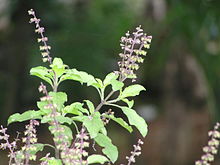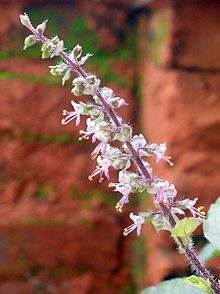Ocimum tenuiflorum
| Ocimum tenuiflorum | |
|---|---|

| |
| Scientific classification | |
| Kingdom: | Plantae |
| Clade: | Tracheophytes |
| Clade: | Angiosperms |
| Clade: | Eudicots |
| Clade: | Asterids |
| Order: | Lamiales |
| Family: | Lamiaceae |
| Genus: | Ocimum |
| Species: | O. tenuiflorum
|
| Binomial name | |
| Ocimum tenuiflorum | |
| Synonyms[1] | |
| |
Ocimum tenuiflorum, commonly known as holy basil, tulsi or tulasi, is an aromatic perennial plant in the family Lamiaceae.[2][3] It is widely cultivated throughout the Southeast Asian tropics.[1][4][5] It is native to tropical and subtropical regions of Asia, Australia and the western Pacific.[1] This plant has escaped from cultivation and has naturalized in many tropical regions of the Americas.[3][6] It is an agricultural and environmental weed.[3]
Tulasi is cultivated for religious and traditional medicine purposes, and also for its essential oil. It is widely used as an herbal tea, commonly used in Ayurveda, and has a place within the Vaishnava tradition of Hinduism, in which devotees perform worship involving holy basil plants or leaves.
Morphology
[edit]

Holy basil is an erect, many-branched subshrub, 30–60 cm (12–24 in) tall with hairy stems. Leaves are green or purple; they are simple, petioled, with an ovate blade up to 5 cm (2 in) long, which usually has a slightly toothed margin; they are strongly scented and have a decussate phyllotaxy. The purplish flowers are placed in close whorls on elongated racemes.[7]
The three main morphotypes cultivated in India and Nepal are Ram tulsi (the most common type, with broad bright green leaves that are slightly sweet), the less common purplish green-leaved (Krishna or Shyam tulsi) and the common wild vana tulsi (e.g., Ocimum gratissimum).[8]
Phytochemicals
[edit]The plant and its oil contain diverse phytochemicals, including tannins, flavonoids, eugenol, caryophyllenes, carvacrol, linalool, camphor, and cinnamyl acetate, among others.[9][10] One study reported that the plant contains an eponymous family of 10 neolignan compounds called tulsinol A-J.[11]
Specific aroma compounds in the essential oil are camphor (32%), eucalyptol (19%), ⍺-bisabolene (17%), eugenol (14%), germacrene (11%) and β-bisabolene (11%).[12][better source needed] In addition, more than 60 different aroma compounds were found through gas chromatography–mass spectrometry analysis of holy basil.[12] However, other studies have stated tulsi essential oil consists mostly of eugenol (70%) β-elemene (11%), β-caryophyllene (8%), and germacrene (2%), with the balance being made up of various trace compounds, mostly terpenes.[13]
Uses
[edit]Culinary
[edit]Tulasi (Sanskrit: Surasa) has been used in Ayurvedic and Siddha practices for its supposed medicinal properties.[14][15]
Thai cuisine
[edit]
The leaves of holy basil, known as kaphrao in the Thai language (Thai: กะเพรา), are commonly used in Thai cuisine for certain stir-fries and curries such as phat kaphrao (Thai: ผัดกะเพรา) — a stir-fry of Thai holy basil with meats, seafood or, as in khao phat kraphao, with rice. Two different types of holy basil are used in Thailand, a "red" variant which tends to be more pungent, and a "white" version for seafood dishes.[16][17] Kaphrao should not be confused with horapha (Thai: โหระพา), which is normally known as Thai basil,[18] or with Thai lemon basil (maenglak; Thai: แมงลัก).
Insect repellent
[edit]For centuries, the dried leaves have been mixed with stored grains to repel insects.[19]
Nematicidal
[edit]The essential oil may have nematicidal properties against Tylenchulus semipenetrans, Meloidogyne javanica, Anguina tritici, and Heterodera cajani.[20]
Disinfection
[edit]Water disinfection using O. tenuiflorum extracts was tested by Bhattacharjee et al. 2013 and Sadul et al. 2009. Both found an alcoholic extract to be more effective than aqueous or leaf juice. Sundaramurthi et al 2012 finds the result to be safe to drink and antimicrobial. A constituent analysis by Sadul found alkaloids, steroids, and tannins in the aqueous, and alkaloids and steroids only in the alcoholic extract.[21]
Significance in Hinduism
[edit]Tulasi is a sacred plant for Hindus, particularly the Vaishnavite sect. It is worshipped as the avatar of Lakshmi,[citation needed] and is often planted in courtyards of Hindu houses or temples to Hanuman.[22] The ritual lighting of lamps each evening during Kartik includes the worship of the tulsi plant.[23][24] Vaishnavites are also known as "those who bear the tulsi around the neck".[22]
Tulasi Vivaha is a ceremonial festival performed between Prabodhini Ekadashi (the 11th or 12th lunar day of the bright fortnight of the Hindu month of Kartika) and Kartik Purnima (the full moon of the month).[25][26]
Every evening, Bengali Hindus place earthen lamps in front of tulsi plants. During the Kati Bihu festival celebrated in Assam, people light earthen lamps (diya) at the foot of the household tulsi plants and pray.[27]
Gallery
[edit]-
Inflorescence
-
Prayer beads made from tulsi wood
See also
[edit]References
[edit]- ^ a b c d "Ocimum tenuiflorum L." Kew, Royal Botanic Gardens. 2023. Retrieved 26 June 2023.
- ^ "Ocimum tenuiflorum". Germplasm Resources Information Network. Agricultural Research Service, United States Department of Agriculture. Retrieved 7 July 2021.
- ^ a b c "Ocimum tenuiflorum (holy basil)". CABI Invasive Species Compendium. 23 August 2014. Retrieved 26 June 2023.
- ^ Staples, George; Michael S. Kristiansen (1999). Ethnic Culinary Herbs. University of Hawaii Press. p. 73. ISBN 978-0-8248-2094-7.
- ^ Warrier, P K (1995). Indian Medicinal Plants. Orient Longman. p. 168. ISBN 978-0-86311-551-6.
- ^ "Ocimum tenuiflorum". Integrated Taxonomic Information System. 26 June 2023. Retrieved 26 June 2023.
- ^ Warrier, P K (1995). Indian Medicinal Plants. Orient Longman. p. 168. ISBN 978-0-86311-551-6.
- ^ Kothari, S. K.; Bhattacharya, A. K.; Ramesh, S.; Garg, S. N.; Khanuja, S. P. S. (November–December 2005). "Volatile Constituents in Oil from Different Plant Parts of Methyl Eugenol-Rich Ocimum tenuiflorum L.f. (syn. O. sanctum L.) Grown in South India". Journal of Essential Oil Research. 17 (6): 656–658. doi:10.1080/10412905.2005.9699025. S2CID 95551382.
- ^ "Holy basil". Drugs.com. 1 February 2022. Retrieved 26 June 2023.
- ^ Sundaram, R. Shanmuga; Ramanathan, M; Rajesh, R; Satheesh, B; Saravanan, D (2012). "LC-MS Quantification of Rosmarinic Acid and Ursolic Acid in Theocimum Sanctumlinn. Leaf Extract (Holy Basil, Tulsi)". Journal of Liquid Chromatography & Related Technologies. 35 (5): 634. doi:10.1080/10826076.2011.606583. S2CID 95225535.
- ^ Singh, Deepika; Chaudhuri, Prabir K. (2018-08-01). "A review on phytochemical and pharmacological properties of Holy basil (Ocimum sanctum L.)". Industrial Crops and Products. 118: 367–382. doi:10.1016/j.indcrop.2018.03.048. ISSN 0926-6690.
- ^ a b Yamani, Hanaa A.; Pang, Edwin C.; Mantri, Nitin; Deighton, Margaret A. (2016). "Antimicrobial Activity of Tulsi (Ocimum tenuiflorum) Essential Oil and Their Major Constituents against Three Species of Bacteria". Frontiers in Microbiology. 7: 681. doi:10.3389/fmicb.2016.00681. ISSN 1664-302X. PMC 4868837. PMID 27242708.
- ^ Padalia, Rajendra C.; Verma, Ram S. (2011). "Comparative volatile oil composition of four Ocimum species from northern India". Natural Product Research. 25 (6): 569–575. doi:10.1080/14786419.2010.482936. PMID 21409717. S2CID 205836713.
- ^ NIIR Board, National Institute of Industrial Research (India) (2004). Compendium of Medicinal Plants. 2004. National Institute of Industrial Research. p. 320. ISBN 978-81-86623-80-0.
- ^ Lesley Braun; Marc Cohen (30 March 2015). Herbs and Natural Supplements, Volume 2: An Evidence-Based Guide. Elsevier Health Sciences. p. 996. ISBN 978-0-7295-8173-8.
- ^ Thompson, David (2010). Thai food (7 ed.). London: Pavilion Books. p. 143. ISBN 9-781862-055148.
- ^ Punyaratabandhu, Leela (2017). Bangkok (1 ed.). New York: Ten Speed Press. p. 338. ISBN 978-0-399-57831-1.
- ^ Gernot Katzer's Spice Pages
- ^ Biswas, N. P.; Biswas, A. K. (2005). "Evaluation of some leaf dusts as grain protectant against rice weevil Sitophilus oryzae (Linn.)". Environment and Ecology. 23 (3): 485–488.
- ^ Chitwood, David J. (2002). "Phytochemical Based Strategies for Nematode Control". Annual Review of Phytopathology. 40 (1). Annual Reviews: 221–249. doi:10.1146/annurev.phyto.40.032602.130045. ISSN 0066-4286. PMID 12147760.
- ^ Pandit, Aniruddha B.; Kumar, Jyoti Kishen (2015-07-24). "Clean Water for Developing Countries". Annual Review of Chemical and Biomolecular Engineering. 6 (1). Annual Reviews: 217–246. doi:10.1146/annurev-chembioeng-061114-123432. ISSN 1947-5438. PMID 26247291.
- ^ a b Simoons, Frederick J. (1998). Plants of life, plants of death. Univ of Wisconsin Press. pp. 7–40. ISBN 978-0-299-15904-7.
- ^ Flood, Gavin D. (2001). The Blackwell companion to Hinduism. Wiley-Blackwell. p. 331. ISBN 978-0-631-21535-6.
- ^ Wilkins, W.J. (2003). Hindu Mythology. New Delhi: D.K. Printworld. p. 471. ISBN 978-81-246-0234-8.
- ^ Underhill, M. M. (1991). The Hindu Religious Year. Asian Educational Services. pp. 129–131. ISBN 978-81-206-0523-7.
- ^ Pawar, Shubhangi; Patil, D. A. (2008). Ethnobotany of Jalgaon District, Maharashtra. Daya Publishing House. p. 400. ISBN 978-81-7035-515-1.
- ^ ANI. "Kati Bihu celebrated in Assam". BW Businessworld. Retrieved 2022-06-09.
External links
[edit] Media related to Ocimum tenuiflorum at Wikimedia Commons
Media related to Ocimum tenuiflorum at Wikimedia Commons


